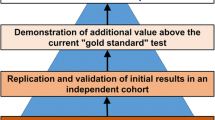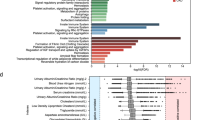Abstract
Diabetic nephropathy (DN) has become the most frequent cause of chronic kidney disease worldwide due to the constant increase of the incidence of type 2 diabetes mellitus in developed and developing countries. The understanding of the pathophysiological mechanisms of human diseases through a large-scale characterization of the protein content of a biological sample is the key feature of the proteomics approach to the study of human disease. We discuss the main results of over 10 years of tissue and urine proteomics studies applied to DN in order to understand how far we have come and how far we still have to go before obtaining a full comprehension of the molecular mechanisms involved in the pathogenesis of DN and identifying reliable biomarkers for accurate management of patients.

Similar content being viewed by others
References
U.S. Renal Data System (2012) USRDS 2012 Annual Data Report: Atlas of Chronic Kidney Disease and End-Stage Renal Disease in the United States. National Institutes of Health, National Institute of Diabetes and Digestive and Kidney Diseases, Bethesda
(2007) KDOQI Clinical Practice Guidelines and Clinical Practice Recommendations for Diabetes and Chronic Kidney Disease. Am J Kidney Dis 49:S1–S179
Craig KJ, Donovan K, Munnery M, Owens DR, Williams JD, Phillips AO (2003) Identification and management of diabetic nephropathy in diabetes clinic. Diabetes Care 26:1806–1811
Gross JL, de Azevedo MJ, Silverio SP, Canani LH, Caramori ML, Zelmanovitz T (2005) Diabetic nephropathy: diagnosis, prevention, and treatment. Diabetes Care 28:164–174
Ziyadeh FN, Sharma K (2003) Overview: combating diabetic nephropathy. J Am Soc Nephrol 14:1355–1357
Stewart JH, McCredie MR, Williams SM et al (2007) Trends in incidence of treated end-stage renal disease, overall and by primary renal disease, in persons aged 20–64 years in Europe, Canada and the Asia-Pacific region, 1998–2002. Nephrology (Carlton) 12:520–527
Rosca MG, Mustata TG, Kinter MT et al (2005) Glycation of mitochondrial proteins from diabetic rat kidney is associated with excess superoxide formation. Am J Physiol Renal Physiol 289:F420–F430
Krolewski AS, Warram JH (1995) Genetic susceptibility to diabetic kidney disease: an update. J Diabetes Complications 9(4):277–2781
Giacco F, Brownlee M (2010) Oxidative stress and diabetic complications. Circ Res 107:1058–1070
Takenaka T, Inoue T, Ohno Y et al (2012) Elucidating mechanisms underlying altered renal autoregulation in diabetes. Am J Physiol Regul Integr Comp Physiol 303(5):R495–R504
Patinha D, Fasching A, Pinho D, Albino-Teixeira A, Morato M, Palm F (2013) Angiotensin II contributes to glomerular hyperfiltration in diabetic rats independently of adenosine type I receptors. Am J Physiol Renal Physiol 304(5):F614–F622
Sochett EB, Cherney DZ, Curtis JR, Dekker MG, Scholey JW, Miller JA (2006) Impact of renin angiotensin system modulation on the hyperfiltration state in type 1 diabetes. J Am Soc Nephrol 17(6):1703–1709
Mathis KM, Banks RO (1996) Role of nitric oxide and angiotensin II in diabetes mellitus-induced glomerular hyperfiltration. J Am Soc Nephrol 7(1):105–112
Kim HJ, Cho EH, Yoo JH et al (2007) Proteome analysis of serum from type 2 diabetics with nephropathy. J Proteome Res 6:735–743
Ziyadeh FN, Snipes ER, Watanabe M, Alvarez RJ, Goldfarb S, Haverty TP (1990) High glucose induces cell hypertrophy and stimulates collagen gene transcription in proximal tubule. Am J Physiol 259:F704–F714
Schordan S, Schordan E, Endlich N et al (2009) Alterations of the podocyte proteome in response to high glucose concentrations. Proteomics 9:4519–4528
Colantonio DA, Chan DW (2005) The clinical application of proteomics. Clin Chim Acta 357:151–158
Mazzucco G, Bertani T, Fortunato M et al (2002) Different patterns of renal damage in type 2 diabetes mellitus: a multicentric study on 393 biopsies. Am J Kidney Dis 39(4):713–720
Thongboonked V, Malasit P (2005) Renal and urinary proteomics: current applications and challenges. Proteomics 5:1033–1042
Bonomini M, Sirolli V, Magni F, Urbani A (2012) Proteomics and nephrology. J Nephrol 25(06):865–871
Magni F, Lalowski M, Mainini V et al (2013) Proteomics imaging and the kidney. J Nephrol 26(3):430–436
Santucci L, Candiano G, Bruschi M et al (2013) Urinary proteome in a snapshot: normal urine and glomerulonephritis. J Nephrol 26(4):610–616
Hummel KP, Dickie MM, Coleman DL (1966) Diabetes, a new mutation in the mouse. Science 153(3740):1127–1128
Chua SC, Chung WK, Wu-Peng XS et al (1996) Phenotypes of mouse diabetes and rat fatty due to mutations in the OB (leptin) receptor. Science 271(5251):994–996
Zhao HJ, Wang S, Cheng H et al (2006) Endothelial nitric oxide synthase deficiency produces accelerated nephropathy in diabetic mice. J Am Soc of Nephrol 17(10):2664–2669
Kurtz TW, Morris RC, Pershadsingh HA (1989) The Zucker fatty rat as a genetic model of obesity and hypertension. Hypertension 13:896–901
Tilton RG, Haidacher SJ, Lejeune WS et al (2007) Diabetes induced changes in the renal cortical proteome assessed with two-dimensional gel electrophoresis and mass spectrometry. Proteomics 7:1729–1742
Zhang D, Yang H, Kong X et al (2011) Proteomics analysis reveals diabetic kidney as a ketogenic organ in type 2 diabetes. Am J Physiol Endocrinol Metab 300:E287–E295
Barati MT, Merchant ML, Kain AB et al (2007) Proteomic analysis defines altered cellular redox pathways and advanced glycation endproduct metabolism in glomeruli of db/db diabetic mice. Am J Physiol Renal Physiol 293:F1157–F1165
Nakatani S, Kakehashi A, Ishimura E et al (2011) Targeted proteomics of isolated glomeruli from the kidneys of diabetic rats: sorbin and SH3 domain containing 2 is a novel protein associated with diabetic nephropathy. Exp Diabetes Res 2011:979354
Reimel BA, Pan S, May DH et al (2009) Proteomics on fixed tissue specimens—a review. Curr Proteomics 6:63–69
Ralton LD, Murray GI (2011) The use of formalin fixed wax embedded tissue for proteomic analysis. J Clin Pathol 64:297–302
Matsuda KM, Chung JY, Hewitt SM (2010) Histo-proteomic profiling of formalin-fixed, paraffin-embedded tissue. Expert Rev Proteomics 7:227–337
Murray GI (2012) Has the proteome of formalin-fixed wax-embedded tissue been unlocked? Nephrol Dial Transplant 27(9):3395–3398
Emmert-Buck MR, Bonner RF, Smith PD et al (1996) Laser capture microdissection. Science 274(5289):998–1001
Nakatani S, Wei M, Ishimura E et al (2012) Proteome analysis of laser microdissected glomeruli from formalin-fixed paraffin-embedded kidneys of autopsies of diabetic patients: nephronectin is associated with the development of diabetic glomerulosclerosis. Nephrol Dial Transplant 27(5):1889–1897
Satoskar AA, Shapiro JP, Bott CN et al (2012) Characterization of glomerular diseases using proteomic analysis of laser capture microdissected glomeruli. Mod Pathol 25(5):709–721
Casadonte R, Caprioli RM (2011) Proteomic analysis of formalin-fixed paraffin-embedded tissue by MALDI imaging mass spectrometry. Nat Protoc 6:1695–1709
Seeley EH, Schwamborn K, Caprioli RM (2011) Imaging of intact tissue sections: moving beyond the microscope. J Biol Chem 286:25459–25466
Thongboonkerd V (2008) Urinary proteomics: towards biomarker discovery, diagnostics and prognostics. Mol BioSyst 4:810–815
Thongboonkerd V (2010) Current stauts of renal and urinary proteomics: ready for routine clinical application? Nephrol Dial Transplant 25:11–16
Bramham K, Mistry HD, Poston L et al (2009) The non-invasive biopsy-will urinary proteomics make the renal tissue biopsy redundant? QJM 102:523–538
Thongboonkerd V (2007) Practical points in urinary proteomics. J Proteome Res 6:3881–3890
Barratt J, Topham P (2007) Urine proteomics: the present and future of measuring urinary protein components in disease. CMAJ 177:361–368
Gonzales-Buitrago JM, Ferreira L, Lorenzo I (2007) Urinary proteomics. Clin Chim Acta 375:49–56
Decramer S, Gonzales de Peredo A, Breuil B et al (2008) Urine in clinical proteomics. Mol Cell Proteomics 7:1850–1862
Schaub S, Wilkins J, Weiler T et al (2004) Urine protein profiling with surface-enhanced laser-desorption/ionization time-of-flight mass spectrometry. Kidney Int 65:323–332
Theodorescu D, Wittke S, Ross MM et al (2006) Discovery and validation of new protein biomarkers for urothelial cancer: a prospective analysis. Lancet Oncol 7:230–240
Papale M, Pedicillo MC, Thatcher BJ et al (2007) Urine profiling by SELDI–TOF/MS: monitoring of the critical steps in sample collection, handling and analysis. J Chromatogr B Analyt Technol Biomed Life Sci 856(1–2):205–213
Yamamoto T, Langham RG, Ronco P, Knepper MA, Thongboonkerd V (2008) Towards standard protocols and guidelines for urine proteomics: a report on the Human Kidney and Urine Proteome Project (HKUPP) symposium and workshop, 6 October 2007, Seoul, Korea and 1 November 2007, San Francisco, CA, USA. Proteomics 8(11):2156–2159
Jackson DH, Banks RE (2010) Banking of clinical samples for proteomic biomarker studies: a consideration of logistical issues with a focus on pre-analytical variation. Proteomics Clin Appl 4(3):250–270
Calvano CD, Aresta A, Iacovone M et al (2010) Optimization of analytical and pre-analytical conditions for MALDI-TOF-MS human urine protein profiles. J Pharm Biomed Anal 51(4):907–914
Court M, Selevsek N, Matondo M et al (2011) Toward a standardized urine proteome analysis methodology. Proteomics 11(6):1160–1171
Yates JR, Ruse CI, Nakorchevsky A (2009) Proteomics by mass spectrometry: approaches, advances, and applications. Annu Rev Biomed Eng 11:49–79
Kolch W, Neussus C, Pelzing M et al (2005) Capillary electrophoresis-mass spectrometry as a power tool in clinical diagnosis and biomarker discovery. Mass Spectrom Rev 34:959–977
Wright GL Jr (2002) SELDI proteinchips MS: a platform for biomarker discovery and cancer diagnosis. Expert Rev Mol Diagn 2:549–563
Rossing K, Mischak H, Dakna M, PREDICTIONS Network et al (2008) Urinary proteomics in diabetes and CKD. J Am Soc Nephrol 19(7):1283–1290
Alkhalaf A, Zürbig P, Bakker SJ, PREDICTIONS Group et al (2010) Multicentric validation of proteomic biomarkers in urine specific for diabetic nephropathy. PLoS ONE 5(10):e13421
Good DM, Zürbig P, Argilés A et al (2010) Naturally occurring human urinary peptides for use in diagnosis of chronic kidney disease. Mol Cell Proteomics 9:2424–2437
Zürbig P, Jerums G, Hovind P et al (2012) Urinary proteomics for early diagnosis in diabetic nephropathy. Diabetes 61(12):3304–3313
Otu HH, Can H, Spentzos D, Nelson RG et al (2007) Prediction of diabetic nephropathy using urine proteomic profiling 10 years prior to development of nephropathy. Diabetes Care 30(3):638–643
Wu J, Chen YD, Yu JK, Shi XL, Gu W (2011) Analysis of urinary proteomic patterns for type 2 diabetic nephropathy by Protein Chip. Diabetes Res Clin Pract 91(2):213–219
Dihazi H, Müller GA, Lindner S et al (2007) Characterization of diabetic nephropathy by urinary proteomic analysis: identification of a processed ubiquitin form as a differentially excreted protein in diabetic nephropathy patients. Clin Chem 53(9):1636–1645
MacIsaac RJ, Tsalamandris C, Panagiotopoulos S, Smith TJ, McNeil KJ, Jerums G (2004) Nonalbuminuric renal insufficiency in type 2 diabetes. Diabetes Care 27:195–200
Ekinci EI, Jerums G, Skene A et al (2013) Renal structure in normoalbuminuric and albuminuric patients with type 2 diabetes and impaired renal function. Diabetes Care 36:3620–3626
Papale M, Di Paolo S, Magistroni R et al (2010) Urine proteome analysis may allow noninvasive differential diagnosis of diabetic nephropathy. Diabetes Care 33(11):2409–2415
Jin J, Ku YH, Kim Y et al (2012) Differential proteome profiling using iTRAQ in microalbuminuric and normoalbuminuric type 2 diabetic patients. Exp Diabetes Res 2012:168602
Shadforth IP, Dunkley TP, Lilley KS, Bessant C (2005) i-Tracker: for quantitative proteomics using iTRAQ. BMC Genom 20(6):145
Cocucci E, Racchetti G, Meldolesi J (2009) Shedding microvesicles: artefacts no more. Trends Cell Biol 19:43–51
Simpson RJ, Lim JW, Moritz RL, Mathivanan S (2009) Exosomes: proteomic insights and diagnostic potential. Expert Rev Proteomics. 6:267–283
Raimondo F, Corbetta S, Morosi L et al (2013) Urinary exosomes and diabetic nephropathy: a proteomic approach. Mol BioSyst 9(6):1139–1146
Papale M, Rocchetti MT, Gesualdo L (2013) Clinical proteomics: the potentiality of urine analysis for understanding diabetic nephropathy. Euro Med J Nephrol (1):32–39
Kohda Y et al (2000) Analysis of segmental renal gene expression by laser capture microdissection. Kidney Int 57:321–331
Chaurand P et al (2006) Molecular imaging of thin mammalian tissue sections by mass spectrometry. Curr Opin Biotechnol 17(4):431–436
Conflict of interest
The authors declare that there are no conflicts of interest.
Author information
Authors and Affiliations
Corresponding author
Rights and permissions
About this article
Cite this article
Papale, M., Di Paolo, S., Vocino, G. et al. Proteomics and diabetic nephropathy: what have we learned from a decade of clinical proteomics studies?. J Nephrol 27, 221–228 (2014). https://doi.org/10.1007/s40620-014-0044-5
Received:
Accepted:
Published:
Issue Date:
DOI: https://doi.org/10.1007/s40620-014-0044-5




